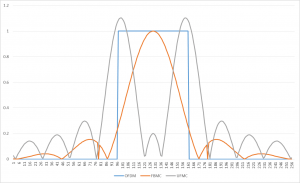Cellular wireless technology moved from the 3rd generation (3G) to the 4thgeneration (4G) with the release of the LTE standards. One of the fundamental changes brought by this technology was the use of Orthogonal Frequency Division Multiplexing, or OFDM. In recent years, OFDM has been widely adopted for broadband wired and wireless communications (vDSL, WiFi, PLC, etc.) because of a number of advantages that it offers: Orthogonality of subcarrier signals using the ingenious trick of inverse FFT (first proposed by Weinstein, Ebert and others 1) allows for both easy generation and easy reception of signals. It does so by using FFT hardware accelerators as well as the conversion of the complex adaptive time-domain equalizer to a relatively simpler frequency domain equalizer.
- Closely spaced orthogonal subcarriers partition the available bandwidth into a maximum collection of narrow sub bands. This allows efficient mitigation of band/frequency specific fading.
- Use of the cyclic prefix relaxes timing synchronization constraints.
Requirements of 5G Networks
When thinking of 5th generation wireless networks, most people think in terms of more bandwidth. However, this is only part of the story. The key technical advancements will come from two emerging concepts: cooperative networking and coexistence.2
Cooperative networking requires network elements (eNodeBs, Ues, or both) to coordinate closely together, on a frame-by-frame basis and to transmit/receive data on shared resources. This will dramatically improve coverage and quality, especially in difficult scenarios (cell-edge, etc.), which are currently underserved by modern networks. In a large number of cases, this coordination may involve small-cells.
Coexistence requires the 5G cellular network to share spectrum with other radio access technologies (4G, WLAN, etc.) in a common geographic area. Multiple radio access technologies (RATs) using common spectrum operate in coordination with each other, i.e. WiFi offload and IFOM. Given this, interference management between RATs will become a key concern when it comes to 5G.
Challenges Of OFDM
It has been established that there are severe practical deployment and performance issues with OFDM (notwithstanding all the positives mentioned above), which limit its usability in the use-cases which are deemed important for 5th generation cellular networks. Over the last few years, OFDM deployments have been slowly gathering steam, both in WiFi and in LTE networks. Gradually, a corpus of data is building up real-life performance in the field, which has provided designers with further insight into the strengths and drawbacks of the technology.
OFDM is based on orthogonality of sub-carriers; this requires strict control of the synthesizer. From the perspective of a single transmitter, this is easy to achieve. However, as discussed above, 5G networks will require tight inter-coordination between multiple network elements and tight sharing of spectrum.
In certain applications where a subset of subcarriers is allocated to each user, such as cognitive radios and multiuser multicarrier systems, OFDM isn’t quite an optimal solution. OFDMA can only operate if strict time and frequency synchronization between users and a base station is achieved. Distributed transmission techniques, such as CoMP, impose an even more stringent requirement of synchronous base stations on top of everything else. As of now, synchronizing cooperative networks is expensive, and in some cases even impossible. The problem only becomes tremendously more challenging when considering low-cost micro and femto base station deployments or even lower-cost sensor devices, which may transmit without synchronizing to the network’s clock.3
Another critical issue in CoMP-OFDM systems is their sensitivity to multiple carrier frequency offsets (CFOs) between terminals and base stations. The frequency offset can be caused by either doppler shift as a result of terminals’ mobility or by oscillator frequency mismatch between a transmitter and a receiver. Multiple CFOs in CoMP-OFDM systems destroy the orthogonality between OFDM subcarriers and causes intercarrier interference (ICI) at the receiver, which leads to significant degradation in system performance. There is also a need to address the spectral efficiency aspect, as future 5G networks will have to use scarce and fragmented spectral resources. It poses extreme challenges when it comes to achieving blocking requirements and satisfying regulatory out-of-band spectrum constraints which cannot be achieved by the spectrum shape of OFDM (OFDM waveforms inherently have large side-lobes because of the rectangular shaping of the temporal signal).
New Developments
There is a need for a filtered, multicarrier approach with reduced side-lobe levels of the waveform which could minimize inter-carrier interference (ICI).
Filter Bank Multi-Carrier
FBMC (filter bank multi-carrier) generalizes traditional orthogonal frequency-division multiplexing (OFDM) schemes, allowing a nonrectangular sub-channel pulse shape in the time domain. This approach leads to a better spectral containment that improves interference mitigation in several time-variant environments. The key idea behind this technique is to perform a nonrectangular pulse-shaping as compliant as possible with the channel characteristics (time and frequency dispersion). From a transmission perspective, the FBMC technique has the potential to increase bit rate, due to the reduced guard bands and the absence of the cyclic prefix needed in OFDM. FBMC also allows the possibility to allocate different subcarriers to different unsynchronized users in a spectrally efficient manner. The out-of-band emission of FBMC is much lower than OFDM.4
FBMC only becomes efficient with offset QAM (OQAM), where the real part of QAM symbols are mapped to one half of the multi-carrier symbols and the imaginary parts are mapped to an interlaced half of the multi-carrier symbols. While this works well with single-cell, single user transmission, in the JR case, we obtain additional interference paths between the interlaced OQAM symbols. Furthermore, certain types of MIMO transmission are not supported by FBMC/OQAM.
Universal Filtered Multi-Carrier
A paramount feature required in future wireless communication systems, supporting the Internet of Things (IoT) and Massive Machine Communication (MMC), is to efficiently support transmission of small data packets. A physical layer enabling this target demands efficient support of short transmission bursts. Here, FBMC/OQAM with its long filter lengths by design loses efficiency. Thus an alternative modulation scheme to FBMC is needed, where a filtering operation is applied to a group of consecutive subcarriers instead of the per subcarrier filtering used in FBMC. By using the technique called universal-filtered multi-carrier (UFMC)5, the effect of side-lobe interference on the immediate adjacent sub-channels is significantly reduced. This offers better ICI robustness and better suitability for fragmented spectrum operation. The UFMC technique uses shorter filter lengths compared to OFDM’s cyclic prefix lengths, making it applicable for short burst communication. The UFMC technique can be considered as a potential candidate for future wireless systems which have to support a plethora of low-cost devices (IoT and MMC).

Comparison of Waveforms
Conclusion
5th generation wireless networks will not only support higher bandwidths than the current LTE networks, but 5G will also be designed from the ground-up for more complex use-cases involving cooperative networking, coexistence, and future support for the IoT and IoV (Internet of Vehicles). The key to a successful design is the understanding of the shortfalls and limitations of the current generation of technology and adapting as necessary in new developments. Research on next generation technologies is currently going at a break-neck speed, working to enhance the 4th generation OFDM approach in order to support these diverse scenarios. The next few years promise to be exciting times for wireless technology, as we will witness the birth of radical new approaches to solving the uncovered problems.
External References
1. Multicarrier Modulation: An idea whose time has come. Bingham, J.A.C. 1990, IEEE Communications Magazine.
2. From LTE-advanced to the future. Baker, M. 2, s.l. : IEEE, 2012, IEEE Communications Magazine, Vol. 50, pp. 116-120. MCOM.2012.6146490.
3. 5G air interface design based on Universal Filtered (UF-)OFDM. Wild, T., Schaich, F. and Yejian Chen. s.l. : IEEE, 2014. Digital Signal Processing (DSP), 2014 19th International Conference on.
4. OFDM Versus Filter Bank Multicarrier. Farhang-Boroujeny, B. 3, 2011, IEEE Signal Processing Magazine, Vol. 28, pp. 92-112.
5. Universal-filtered multi-carrier technique for wireless systems beyond LTE. Vakilian, V., et al. s.l. : IEEE, 2013. Globecom Workshops (GC Wkshps), 2013 IEEE.

 Product Engineering Services Customized software development services for diverse domains
Product Engineering Services Customized software development services for diverse domains
 Sustenance Engineering Going beyond maintenance to prolong life of mature products
Sustenance Engineering Going beyond maintenance to prolong life of mature products
 Managed Services Achieve scalability, operational efficiency and business continuity
Managed Services Achieve scalability, operational efficiency and business continuity
 Technology Consulting & Architecture Leverage the extensive knowledge of our Domain Experts
Technology Consulting & Architecture Leverage the extensive knowledge of our Domain Experts



























